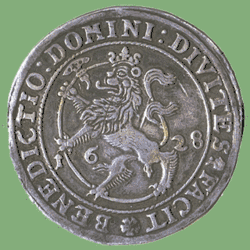Norwegian rigsdaler
The rigsdaler was the unit of currency used in Norway until 1816 and in Denmark until 1873. The similarly named Reichsthaler, riksdaler and rijksdaalder were used in Germany and Austria-Hungary, Sweden and the Netherlands, respectively.
History
During the real union between Denmark and Norway, Danish currency circulated alongside Norwegian. Norway itself issued currency denominated in two different rigsdaler, the rigsdaler courant and the rigsdaler specie, with 96 skilling to the rigsdaler courant and 120 skilling to the rigsdaler specie.
In 1816, following the establishment of the union between Sweden and Norway, the rigsdaler specie was renamed the speciedaler and became the standard unit of currency in Norway.
Coins

In the late 18th and early 19th centuries, coins were issued in denominations of 1, 2, 4, 8 and 24 skilling, 1⁄15, 1⁄5, 1⁄3, 1⁄2, 2⁄3 and 1 rigsdaler specie.
Banknotes
In 1695, government notes were issued for 10, 20, 25, 50 and 100 rigsdaler (spelt rixdaler).[1] In 1807, notes were reintroduced by the government, in denominations of 1, 5, 10 and 100 rigsdaler courant, with 12 skilling notes added in 1810.[1] In 1813, Rigsbankens Norske Avdeling began issuing notes.[1] in denominations of 1, 5, 50, and 100 Rigsbankdaler.[2] Subsequent series were issued by Norges Midlertidige Rigsbank (1814), Stattholderbevis (1815), and Norges Bank (1817–22 to the present).[3]
Norwegian speciedaler
The speciedaler (or specie-dollar) was the currency of Norway between 1816 and 1875. It replaced the rigsdaler specie at par and was subdivided into 5 marks or 120 skilling (called skilling species on some issues), each mark therefore subdivided into 24 skillings. It was replaced by the Norwegian krone when Norway joined the Scandinavian Monetary Union. An equal valued krone/krona of the monetary union replaced the three currencies at the rate of 1 krone/krona = 1⁄2 Danish rigsdaler = 1⁄4 Norwegian speciedaler = 1 Swedish riksdaler.
Coins
In 1816, coins in circulation from the previous currency remained in circulation, with only 1 skilling coins being minted. A new coinage was introduced in 1819, consisting of copper 1 and 2 skilling and silver 8 and 24 skilling, 1⁄2 and 1 specidaler. Silver 2 and 4 skilling coins were introduced in 1825, followed by copper 1⁄2 skilling pieces in 1839, silver 12 skilling in 1845 and silver 3 skilling in 1868. It was made out of Iron.
Banknotes
Norges Bank began issuing notes in 1817, with denominations of 24 skilling, 1⁄2, 1, 5, 10, 50 and 100 speciedaler.
Notes
- Cuhaj 2010, p. 921.
- Cuhaj 2010, p. 922.
- Cuhaj 2010, pp. 922-28.
References
- Cuhaj, George S., ed. (2010). Standard Catalog of World Paper Money General Issues (1368-1960) (13 ed.). Krause. ISBN 978-1-4402-1293-2.CS1 maint: ref=harv (link)
- Krause, Chester L.; Clifford Mishler (1991). Standard Catalog of World Coins: 1801–1991 (18th ed.). Krause Publications. ISBN 0873411501.
- Pick, Albert (1994). Standard Catalog of World Paper Money: General Issues. Colin R. Bruce II and Neil Shafer (editors) (7th ed.). Krause Publications. ISBN 0-87341-207-9.
.jpg)